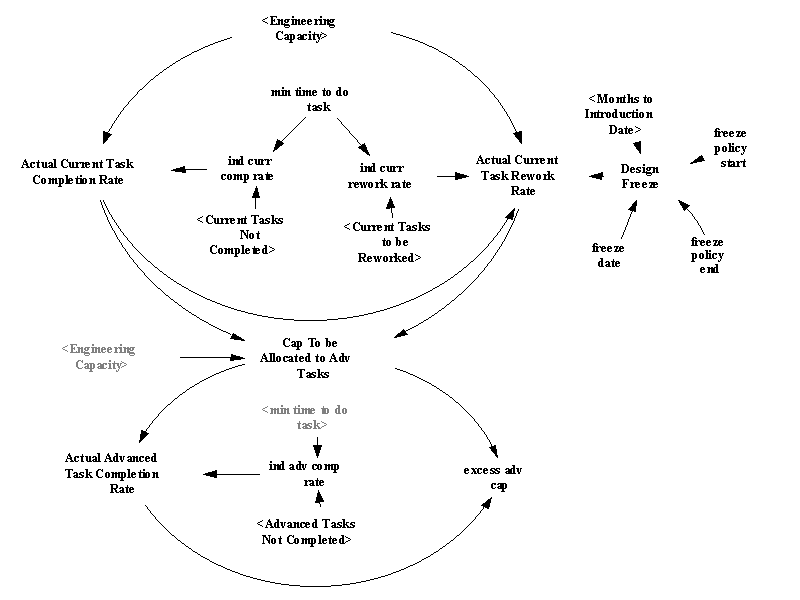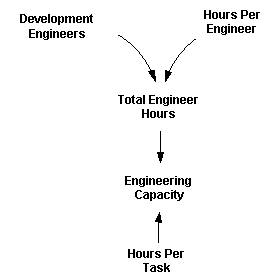
Allocation of Engineering Capacity

The critical decision function in the model is the allocation of engineering capacity between the three types of development work Current Work, Current Rework and Advanced Work. Calculation of Engineering Capacity is explained in the Engineering Resources Sector.
First, the indicated work rate is calculated. This is the rate at which work can be done when the least amount of time is invested, thus the maximum rate of work.
(123) min time to do task=1
Units: Month
The Minimum time to do task is given to be 1 month. This value is used to determine the flow of the maximum work rates.
(113) ind curr comp rate= Current Tasks Not Completed/min time to do task
Units: tasks/Month
Indicated Completion Rate of Current Engineering Changes. This represents the maximum work rate for current new work. It is the rate at which work can be done when capacity is not a constraint and the least amount of time is invested.
(115) ind curr rework rate= Current Tasks to be Reworked/min time to do task
Units: tasks/Month
Indicated Completion Rate for Current Rework. This represents the maximum work rate for current rework. It is the rate at which work can be done when capacity is not a constraint and the least amount of time is invested.
(111) ind adv comp rate= Advanced Tasks Not Completed/min time to do task
Units: tasks/Month
Indicated Completion Rate of Advanced Tasks. This represents the maximum work rate for advanced new work. It is the rate at which work can be done when capacity is not a constraint and the least amount of time is invested.
Second, the actual work rates are calculated. These actual work rates are the flows in the
Current Work and Advanced Work Sectors. Two rules are used 1) new work takes priority of rework, and 2) current work takes priority over advanced work. Thus, capacity is allocated in the order of Current Work, Current Rework followed by Advanced Work. So, all the engineering capacity available is allocated to Current Work. This is achieved by using a MIN-function between Engineering Capacity and the maximum feasible current work completion rate. Next, all the capacity left over and the maximum feasible current rework rate is compared in the same manner. Then a similar process is used to get the actual advanced completion rate. Finally, whatever capacity left over is noted as excess advanced capacity.(003) Actual Current Task Completion Rate = MIN(Engineering Capacity,ind curr comp rate)
Units: tasks/Month
Actual Completion Rate of New Current Tasks. If there is a need all the available capacity is allocated. The completion of new work has priority over all other tasks. However, to ensure that only work gets done if there is work to do, the flow is protected by a Min function.
(005) Actual Current Task Rework Rate= MIN(Engineering Capacity-Actual Current Task Completion Rate,ind curr rework rate) * Design Freeze
Units: tasks/Month
Actual Current Task Rework Rate is equal to the minimum of either the indicated current rework rate or whatever capacity is remaining after doing the current new work. The MIN-function is to ensure that the rework rate is a reasonable value. The design freeze switch is multiplied to represent when no more rework is done. So, when design freeze takes effect, the designs which failed testing are not reworked and only the designs that pass testing are considered to be completed tasks.
(025) Cap To be Allocated to Adv Tasks= MAx(Engineering Capacity-(Actual Current Task Completion Rate+Actual Current Task Rework Rate),0)
Units: tasks/Month
Development Capacity for Advanced Tasks can be allocated if there is excess engineering capacity. This represents that the advanced tasks are done only after the current work is done.
(001) Actual Advanced Task Completion Rate =MIN(Cap To be Allocated to Adv Tasks, ind adv comp rate)
Units: tasks/Month
Actual Completion Rate of Advanced Tasks. All the capacity available for advanced work is allocated to the new work rate. So, the advanced new work rate is the indicated advanced completion rate or whatever capacity is available to advanced work.
Design Freeze
One of the policies that can be tested with this model is that of design freeze. When design is frozen, the completed tasks are considered to be final and no changes are to be made to the design. Thus, no resources are allocated to Current Rework. One may simulate the "Freeze Policy" by specifying the parameters accordingly.
One may have a freeze policy start and end date so that the policy only gets implemented during that time period. During this interval, designs are frozen from the point when "months to job one" is less than the "freeze date". For example, a value of "Freeze Date = 6" would mean that no more changes are made to the design when there are less than 6 months to job one.
(068) Design Freeze=IF THEN ELSE(Months to Introduction Date<freeze date*(step(1,freeze policy start)-step(1,freeze policy end)),0,1)
Units: dimensionless
Switch to Freeze Designs. The switch is on when it returns value 0 and off when it returns value 1. This is so because the value of "Design Freeze" is multiplied to "actual current rework rate".
(091) freeze date= 0
Units: months
Date at Which Designs are Frozen in each 12 month cycle. The value represents the date in "months to job one". For example, a value of 6 would mean that design is frozen when there are less than 6 months to job one.
(092) freeze policy end = 1e+009
Units: Month
Date when freeze policy ends during the simulated time.
(093) freeze policy start= 1
Units: Month
Date at Which Freeze Policy Starts during the simulation time.
Engineering Resources

This Sector calculates the Capacity Available given the resources of Development Engineers and the Hours Per Engineer works in a month. First, the Total Engineering Hours are calculated. This is simply the total "hours per month" that is available. From this, according to the time allocated per task, we can calculate capacity under different situations.
The Average Hours it takes per Task is assumed to be 200 hours/task. So, Engineering Capacity (in units of Tasks/Month) is determined by dividing the Total Engineer Hours by this average value.
(069) Development Engineers = 300
Units: engineers
The number of Development Engineers available.
(096) Hours Per Engineer = 200
Units: hours/engineer/Month
The average number of hours an engineer works in a month.
(141) Total Engineer Hours = Development Engineers*Hours Per Engineer
Units: hours/Month
Total Engineering Hours available each month.
(097) Hours Per Task = 200
Units: hours/task
The average number of hours it takes to complete a task.
(070) Engineering Capacity = Total Engineer Hours/Hours Per Task
Units: tasks/Month
Engineering capacity is the number of tasks that can be completed each month when certain number of hours (Hours Per Task) are allocated to each task.
The capacity that is calculated here is used in other sectors especially in the Capacity Allocation Sector, which uses these values to limit the actual work rates.




|
Overview | Advanced Work | Current Work | Current Defects | Market Defects | Capacity Allocation |